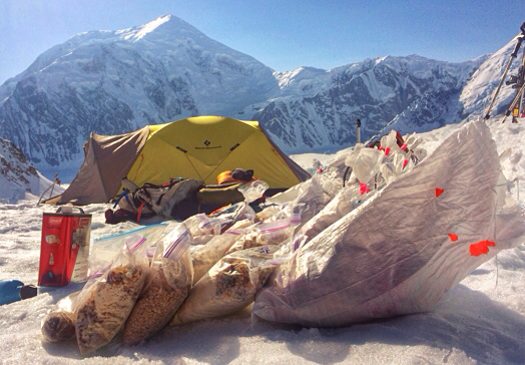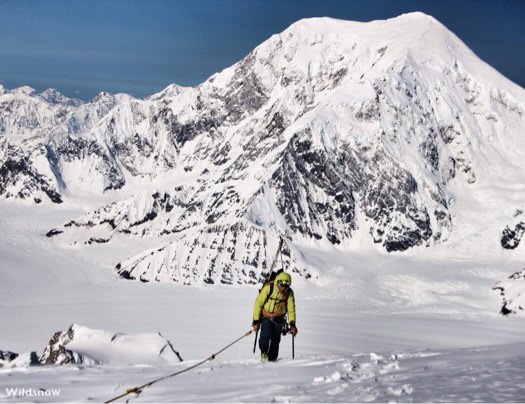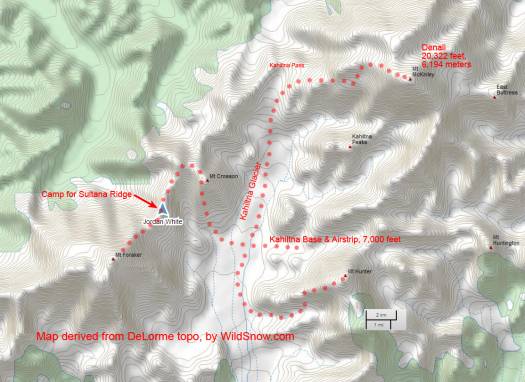Evan Pletcher
Updates from the editors:
Update May 22, 11:00 am MST: I got on the phone with Andrew McLean, who was the first guy to ski the “Denali Family,” or “Big 3” as we’re calling it here. “They’re such great ski peaks,” he said, “everyone should consider them — but they’re serious, with big logistics and in the case of Foraker you are so exposed on that ridge. Don’t forget that climbers have literally been blown off of Foraker and never found. The acceleration of how fast these trips are done is fascinating — it’s cool to see Jordan get all three done, and if they do it all in one trip that’s impressive. The first week of June is the sweet spot for skiing Denali, so hopefully that’ll work out!”
NOTE: As during the WildSnow Denali trip of 2010, a big part of SkiTheBig3’s success is in accurate weather forecasting. The magic is done by meteorologist Joel Gratz of Open Snow, thanks Joel!
Update May 22, 6:00 am MST: The guys are all back safe at Kahiltna Base (see map at bottom of post), where their food cache is located. Sounds like they’ll be taking a few rest days. Jordan writes that they’re all “very tired.” Figures, as they did somewhat of a tour-de-force in climbing and skiing Mount Foraker within a 6 day period. Doing Foraker via Sultana Ridge involves climbing up and over Mount Crosson (12,352 feet, 3,765 m), negotiating several miles of ice-capped ridge in a very exposed situation, and finally topping out at 17,400 feet, (5,304 m) on an Alaskan giant that only gets climbed a few times a year. After that, your return trip again involves several miles of ridge and a climb back up and over Crosson, finished with descending 5,000 vertical feet off Crosson to Kahiltna Base!
Jordan will be filing a trip report sometime today or tomorrow. For now I want to again congratulate Aaron, Evan, Anton and Jordan on executing a big Alaska Range climb with courage yet restraint and respect for the Alaskan alpine environment (as well as operating in alpine style with single carries).
Also, as far as we know this makes expedition member Jordan White the second person to have skied the big three Alaska Range peaks, Hunter, Foraker, Denali. (He skied Denali in 2010 during our WildSnow expedition.) Well known ski alpinist Andrew Mclean came up with the concept of skiing the big three, and was the first to complete the project with his ski of Foraker via Sultana in 2009.
Update May 21, 8:00 am MST: Crew is “headed down from Crosson to Kahiltna Base in a few hours.” Note we added an improved map to the bottom of this post.
Update May 20 pm: We just got a SPOT message from the SUMMIT OF MOUNT FORAKER! Soon after, I got a satphone call from Jordan saying they’d SKIED SULTANA RIDGE, MOUNT FORAKER and were back in camp on Mount Crosson. CONGRATULATIONS FROM US HERE AT WILDSNOW!!!
I have to admit that after this push, I’m hoping these guys have a more leisurely stroll up the Kahiltna to get in position for climbing and skiing Denali. Just getting the reports is leaving me out of breath (grin), I need a break!
Update May 20: The guys don’t have their solar recharging system at high camp on Mount Crosson (next to Mount Foraker), so they can’t send photos. But Jordan has his inReach going and filed this report in a series of SMS messages:
“Sitting here in the tent playing 20 questions. We left Kahiltna base Thursday afternoon and crossed the Kahiltna to the base of Crosson. After climbing through the bergschrund we actually got to travel unroped! We pushed to the 10,000 level on Crosson and made camp. Friday morning we left 10,000 camp and moved up and over Crosson to the col between Crosson and pnt 12,472. We were able to carry across a lower traverse on 12,472 and come most of the way across the ridge before a storm hit.”
“A whiteout hit on the ridge, so we reversed for about ten minutes to our current location to camp. Our location adds about an hour to the base of Sultana ridge, but it’s well protected. Yesterday (Saturday May 18) we made a summit bid, but after encountering winds at 14,000 foot elevation of over 40 mph and taking a look at the summit plume, and the clouds trying to fight their way over the ridge, we turned around. We are back at camp with clear but windy conditions, waiting for a summit bid, or we will have to retreat. Tuesday doesn’t look great, but we may have a weather window on Wednesday. Till then it’s the waiting game. We’ve done everything so far with single carries. Brutal, but in the end that makes things go smooth and fast compared to siege tactics. Downside is we don’t have much food or fuel and we’ll have to return to Kahiltna base if we don’t soon get a weather break.”
Update May 18: Summit attempt on Foraker, aborted because of wind; they made it to 14,200 feet.
May 16: They’ve moved camp over Mount Crosson, they’re camped at 11,800 feet on the ridge that connects to Sultana ridge on Foraker.
Evening of May 15 MST: Jordan just sent a satellite message, they’re camped at 10,000 feet on Mount Crosson. He says it was “brutal” getting there. Should we expect anything less (grin)? See bottom of post for Google map with marker on Mount Foraker summit and Mount Crosson labeled. Interestingly, Google doesn’t name Mount Mckinley (Denali) or Mount Foraker on their map!!! Sheesh, shows you how far we have to go with mapping still. When you look at the map, observe the gigantic cirque/valley to the left (southwest) of Mount Crosson. You would think this is a much more direct way to get Foraker, than by a circuitous trudge up and over Mount Crosson. The gigantic cirque was indeed the climbing route for some of the original ascents, but gets swept regularly by apocalyptic avalanches. Indeed, in 1976 two Japanese expeditions lost nearly all their members to fatigue and avalanches by attempting this dangerous yet more direct route. Alpinists do learn from others’ mistakes. Hence, Sultana ridge attempts usually go by climbing Crosson first, then using the safer ridge traverse to access the main Sultana ridge coming off the Foraker summit. Quite a bit more work, but much more sustainable.

Our tent and food cache at Kahiltna Base, Mount Foraker tempting us, Sultana Ridge to right of summit.
Hello everyone. I’m writing this while still camped at Kahiltna Base. With today May 15 being our second day of rest in a row there has been an obvious change in our team’s energy level. Bruises and blisters are healing, backs are loosening up and the color of my face has decreased in pigmentation from fire engine red to dark pink (lesson learned, apply sunscreen every 30 minutes up here…).

A few days ago, photo from Mount Hunter climb and ski, looking at Mount Foraker with Sultana Ridge dropping to right.
We plan on moving to the base of Mount Crosson in the morning (or possibly a little bit higher to camp 1 or 2) and have been strategizing after our experience climbing Mt. Hunter ways to climb leaner and more efficiently. All of us have picked through our packs and removed items that were unused on Hunter and seem unnecessary for Foraker. Ski carry systems and pack organization has been improved to allow for quicker transitions and minor repairs have been made as needed.
We’ll climb alpine style and bring 6 days of food (which we can easily stretch to 10) and 2 gallons of fuel to Foraker. We hope that by traveling light and avoiding sled hauling or double carrying that we will be able to move efficiently up Crosson and over to Foraker. The decision to travel as such was made as a result of a forecast the looks appealing through Sunday when we hope to summit.
At this point glacier life is starting to feel normal and we are falling into a rhythm that seems sustainable for some time to come. With showers all around and clean clothes we expect to set out tomorrow refreshed, stronger than ever, and ready for our next adventure!
Info from Lou, researched from Waterman’s “High Alaska” book and some Google action: Mount Foraker is 17,004 feet high and the sixth highest in North America. Native American name for the peak is Sultana, apparently meaning something like the wife of Denali. Hopefully the Big3 guys are not reading this, as I don’t want to remind them about women, of which they are woefully deprived. Those with more knowledge please correct me, but as far as I know Foraker has been skied by three routes. What’s probably the best ski route is also the most efficient and safest climbing route: that of first climbing Mount Crosson north of Foraker, then traversing a lengthy ridge to the summit of Foraker and returning via same route, known as Sultana Ridge. In 1981, alpinist Pierre Beghin made the first ski descent of the peak via the Southeast Ridge. This is normally a fairly difficult alpine climbing route; his skiing required a number of belays on exceptionally steep and exposed sections. The third of the existing ski routes is Archangel Ridge, dropping directly north off the summit. All routes are difficult to find in condition for skiing, with Sultana being the most likely, though it involves a lot of maneuvering around crevasses and ice features. I don’t want to get into a lengthy history here, but it should be mentioned that so far the only guy I know of who’s skied the Big 3 is Andrew McLean, over several years of fascinating and well executed Alaska Range expeditions. Google all the routes for more info.
(‘Ski The Big 3 is an Alaskan ski mountaineering expedition cooked up by four deprived (or perhaps depraved?) guys who never get enough ski and snowboard mountaineering. Aaron Diamond, Evan Pletcher, Anton Sponar, Jordan White. The idea is to ski Denali, Mount Foraker, and Mount Hunter all during one expedition. They’ve got six weeks worth of food and enough camera gear to outfit a small army. Should be interesting. We wish them safe travels, we’re enjoying being their blog channel.)

Ski The Big 3 routes both done and proposed. Metrics: Kahiltna Base is at 7,000 feet elevation, Denali (Mount McKinley) tops out at 20,322 feet, 6,194 meters. Click to enlarge. Derivative work based on screen grab from paid DeLorme subscription.
Beyond our regular guest bloggers who have their own profiles, some of our one-timers end up being categorized under this generic profile. Once they do a few posts, we build a category. In any case, we sure appreciate ALL the WildSnow guest bloggers!
